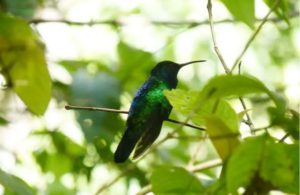Back from Extinction?: The Emerald Green Hummingbird Found Alive.
The Santa Mara Sabrewing has miraculously been rediscovered after being classified as extinct for the last thirteen years. Also known as the Emerald Green Hummingbird, this small but magnificent beauty was found by researchers in Sierra Nevada de Santa Marta region in Columbia, whilst on the search for parrots.
Yurgen Vega, the local researcher who made this unexpected discovery told The Guardian that he felt “overcome with emotion” when he found the Santa Marta Sabrewing perched in the forest. This unexpected sighting is made even more special when we consider that Venga’s documentation is only the third documentation of the bird ever! It has previously been photographed once in 1946 and another in 2010, making it a very unique find.
Vega further detailed how the vital sighting was a complete surprise: “When I first saw the hummingbird, I immediately thought of the Santa Marta Sabrewing. I couldn’t believe it was waiting there for me to take out my camera and start shooting.”
As one of the 24 bird species known to the Sierra Nevada region, the male characteristics of the Santa Marta Sabrewing are emerald plumage with a blue throat and a black bill. Although they are seen as a spectacular beauty, compared to other birds within this region they are relatively small. Spanning approximately 13 cm long, they tend to stay nearer the edges of humid forests. More specifically, they prefer banana plantations that allows them to feed on the flowering banana, although little is known of their feeding behavior. Therefore, making this recent discovery even more important in learning about their habitat and feeding behaviors.
This same thought is also expressed by Esteban Botero-Delgadillo, director of the conservation group Selva: “This finding confirms that we still know very little about many of the most vulnerable and rare species out there, and it is imperative to invest more in understanding them better.” This is even more pertinent when we consider the continued deforestation in the Santa Marta area.
Due to extensive habitat loss, the Santa Marta Sabrewing was listed as critically endangered in 2020. This was deduced after it was found to have a very small range, thought to have numbered less than 50 mature individuals. This unfortunate statistic is due to the large amounts of deforestation in the area. Approximately 85% of the original vegetation in its range has been destroyed after the years of logging, as well the conversion of the habitat into agriculture, grazing and human habitation. As an unfortunate consequence of the deforestation, all that is left of the area is degraded and fragmented. Scientists also predict that climate change has had a huge effect on the Santa Nevada woodland, greatly extending the region’s dry season and increasing the risk of wildfires. Usually, the dry season lasts from December to April, however this could be seen to increase to several months in the coming years.
Nevertheless, not all hope is lost, as the rediscovery of the Santa Mara Sabrewing will encourage collaboration between officials and local conservationists to push forward operations in better protecting the remains of the forest. This will not only be advantageous for the Sebrewing, but also a large collection of other species that inhabit there. Namely, other endangered creatures include the Santa Marta Parakeet, as well as critically endangered frog species such as Atelopus laetissmus and the Atelopus nahumae. The protection of such wildlife, alongside the Sabrewing is, is supported by organisations including the World Land Trust, Robert Wilson Trust, and the Marshall-Reynolds Foundation.
As Botero-Delgadillo aptly puts it: “It is the knowledge that drives action and change – it is not possible to conserve what we don’t understand.” As such, the rediscovery of this beautiful creature cannot be underestimated, as it provides an opportunity for the flourishing of the habitat and subsequent wildlife of Santa Marta. It also provides further hope for other species further afield who may be in danger of being extinct, as well as vitally demonstrating that the rehabilitation and flourishing of our beautiful planet is possible.







